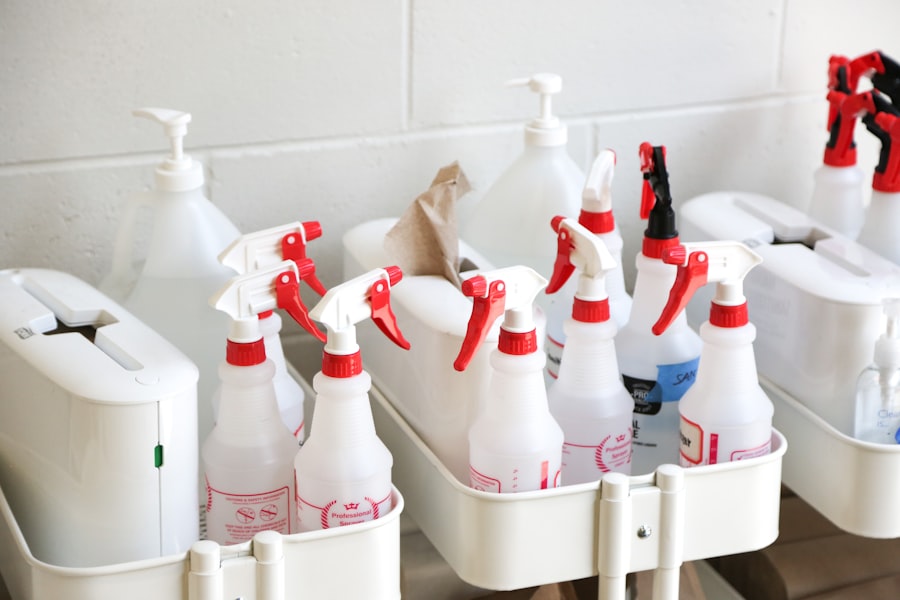In today’s world, the significance of green cleaning cannot be overstated. As you become more aware of the impact that traditional cleaning products have on both your health and the environment, you may find yourself seeking alternatives that are safer and more sustainable. Green cleaning emphasizes the use of environmentally friendly products and practices that minimize harm to both your indoor spaces and the planet.
By adopting these methods, you not only contribute to a healthier home but also play a part in preserving the environment for future generations. Moreover, green cleaning is not just about using different products; it’s a holistic approach to maintaining cleanliness while being mindful of the ecological footprint. You may be surprised to learn that many conventional cleaning agents contain harmful chemicals that can lead to respiratory issues, skin irritations, and other health problems.
By choosing green cleaning, you are making a conscious decision to protect your well-being and that of your family. This shift towards eco-friendly practices is not merely a trend; it represents a growing awareness of our collective responsibility to care for the Earth.
Key Takeaways
- Green cleaning is important for the health of both people and the environment.
- Common household cleaning chemicals to avoid include ammonia, chlorine, and phthalates.
- Eco-friendly cleaning products and ingredients include vinegar, baking soda, and essential oils.
- Making your own green cleaning solutions can save money and reduce waste.
- Using environmentally safe cleaning products can improve indoor air quality and reduce water pollution.
Common Household Cleaning Chemicals to Avoid
As you navigate the aisles of your local supermarket, it’s essential to be aware of the common household cleaning chemicals that can pose risks to your health and the environment. Many popular cleaning products contain substances like ammonia, bleach, and phthalates, which can release toxic fumes and contribute to indoor air pollution. Ammonia, for instance, is often found in glass cleaners and can irritate your eyes, skin, and respiratory system.
By avoiding these harsh chemicals, you can create a safer living space for yourself and your loved ones. Another group of chemicals to steer clear of includes synthetic fragrances and dyes. While they may make your home smell fresh, these additives can trigger allergies and asthma attacks in sensitive individuals.
Additionally, many of these substances are derived from petroleum, which raises concerns about their environmental impact. By being vigilant about the products you choose, you can significantly reduce your exposure to harmful chemicals and promote a healthier home environment.
Eco-Friendly Cleaning Products and Ingredients

When it comes to eco-friendly cleaning products, you have a plethora of options at your disposal. Many brands now offer biodegradable cleaners made from natural ingredients that are effective yet gentle on both surfaces and the environment. Look for products that are labeled as non-toxic, biodegradable, and free from synthetic fragrances or dyes.
These products not only clean effectively but also break down safely after use, minimizing their impact on landfills and waterways. In addition to commercial eco-friendly products, you might consider using simple ingredients that you likely already have in your kitchen. Vinegar, baking soda, and lemon juice are powerful cleaning agents that can tackle a variety of household tasks.
For instance, vinegar can effectively cut through grease and disinfect surfaces, while baking soda serves as a gentle abrasive for scrubbing. By incorporating these natural ingredients into your cleaning routine, you can achieve a sparkling clean home without compromising your health or the environment.
Tips for Making Your Own Green Cleaning Solutions
| Ingredient | Usage | Benefits |
|---|---|---|
| Vinegar | Mix with water for an all-purpose cleaner | Natural disinfectant and deodorizer |
| Baking Soda | Use as a scrub for tough stains | Non-toxic and gentle abrasive |
| Lemon Juice | Add to water for a fresh-scented cleaner | Natural antibacterial and antiseptic properties |
| Castile Soap | Mix with water for a gentle cleaner | Biodegradable and versatile |
Creating your own green cleaning solutions can be both cost-effective and rewarding. You may find that making your own cleaners allows you to customize them according to your preferences while ensuring that they are free from harmful chemicals. Start with basic recipes that utilize common household ingredients.
For example, a simple all-purpose cleaner can be made by mixing equal parts water and vinegar in a spray bottle. This solution is perfect for countertops, sinks, and other surfaces. Another effective homemade cleaner involves combining baking soda with water to form a paste.
This paste can be used to scrub away tough stains in kitchens and bathrooms. If you prefer a pleasant scent in your cleaning solutions, consider adding a few drops of essential oils like tea tree or lavender, which also possess natural antibacterial properties. By experimenting with different combinations, you can discover what works best for your cleaning needs while embracing the principles of green cleaning.
Benefits of Using Environmentally Safe Cleaning Products
The benefits of using environmentally safe cleaning products extend beyond just personal health; they also encompass broader ecological advantages. When you opt for green cleaning solutions, you contribute to reducing the amount of harmful chemicals released into the environment. Traditional cleaning products often end up in waterways through runoff or improper disposal, leading to pollution that affects aquatic life and ecosystems.
By choosing eco-friendly alternatives, you help mitigate this issue and promote cleaner water sources. Additionally, using environmentally safe products can enhance the overall air quality in your home. Many conventional cleaners emit volatile organic compounds (VOCs) that can linger in the air long after use, leading to headaches and respiratory discomfort.
In contrast, green cleaning products typically have lower VOC levels or are entirely VOC-free, resulting in fresher indoor air. This improvement in air quality can lead to better health outcomes for you and your family, making green cleaning not just an ethical choice but also a practical one.
How to Implement Green Cleaning Practices in Your Home

Implementing green cleaning practices in your home is easier than you might think. Start by assessing the cleaning products you currently use and gradually replace them with eco-friendly alternatives. You don’t have to overhaul your entire cleaning routine overnight; instead, consider making small changes over time.
For instance, when you run out of a conventional cleaner, opt for a green version instead. This gradual transition allows you to adapt without feeling overwhelmed. In addition to changing your products, consider adopting new cleaning habits that align with green principles.
For example, instead of using disposable paper towels for every spill or mess, switch to reusable cloths or microfiber towels that can be washed and reused multiple times. This simple change not only reduces waste but also saves you money in the long run. Furthermore, focus on decluttering your space regularly; less clutter means less dust accumulation and fewer surfaces to clean, making your green cleaning efforts more efficient.
Green Cleaning in Commercial and Industrial Settings
The principles of green cleaning extend beyond residential spaces; they are equally important in commercial and industrial settings. Businesses are increasingly recognizing the value of adopting eco-friendly cleaning practices not only for compliance with regulations but also for enhancing employee well-being and productivity. By implementing green cleaning protocols in offices, schools, and healthcare facilities, organizations can create healthier environments for their staff and clients.
In commercial settings, using environmentally safe products can also improve a company’s public image. Consumers today are more conscious of sustainability issues and often prefer to support businesses that prioritize eco-friendly practices. By showcasing your commitment to green cleaning, you can attract environmentally conscious customers while contributing positively to the community and the planet.
The Future of Green Cleaning: Innovations and Trends
As awareness of environmental issues continues to grow, the future of green cleaning looks promising with numerous innovations on the horizon. Companies are investing in research and development to create more effective eco-friendly products that meet consumer demands without compromising safety or efficacy. For instance, advancements in biotechnology are leading to the creation of enzymes that break down dirt and grime more efficiently than traditional chemicals.
Additionally, trends such as zero-waste packaging are gaining traction within the green cleaning industry. Many brands are now offering refillable containers or concentrated formulas that reduce plastic waste significantly. As consumers become more educated about sustainability issues, they will likely continue to seek out products that align with their values.
This shift will drive further innovation in green cleaning solutions, making it easier than ever for individuals and businesses alike to adopt environmentally responsible practices. In conclusion, embracing green cleaning is not just a personal choice; it is a collective movement towards a healthier planet. By understanding the importance of eco-friendly practices and making informed decisions about the products you use, you contribute positively to both your well-being and the environment around you.
Whether at home or in commercial settings, adopting green cleaning methods is an essential step towards creating a sustainable future for all.
FAQs
What is environmentally safe cleaning?
Environmentally safe cleaning refers to the use of cleaning products and methods that are designed to have minimal impact on the environment. This includes using non-toxic, biodegradable, and sustainable ingredients, as well as reducing waste and energy consumption.
Why is environmentally safe cleaning important?
Environmentally safe cleaning is important because traditional cleaning products often contain harmful chemicals that can pollute the air and water, harm wildlife, and have negative health effects on humans. By using environmentally safe cleaning products and methods, we can reduce our impact on the environment and protect our health.
What are some examples of environmentally safe cleaning products?
Examples of environmentally safe cleaning products include vinegar, baking soda, hydrogen peroxide, castile soap, and essential oils. These products are non-toxic, biodegradable, and can be used to clean a wide variety of surfaces and materials.
How can I make my own environmentally safe cleaning products?
You can make your own environmentally safe cleaning products using simple ingredients like vinegar, baking soda, and essential oils. There are many recipes available online for making your own all-purpose cleaners, glass cleaners, and more.
Are environmentally safe cleaning products effective?
Yes, environmentally safe cleaning products can be just as effective as traditional cleaning products. Many natural ingredients have powerful cleaning properties and can be used to effectively clean and disinfect surfaces without harming the environment.
